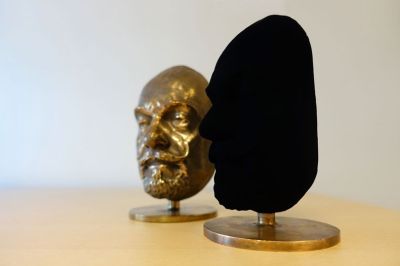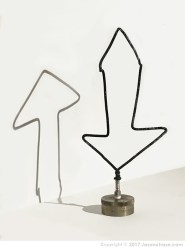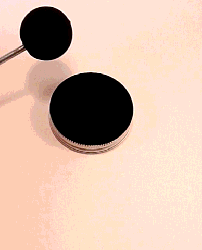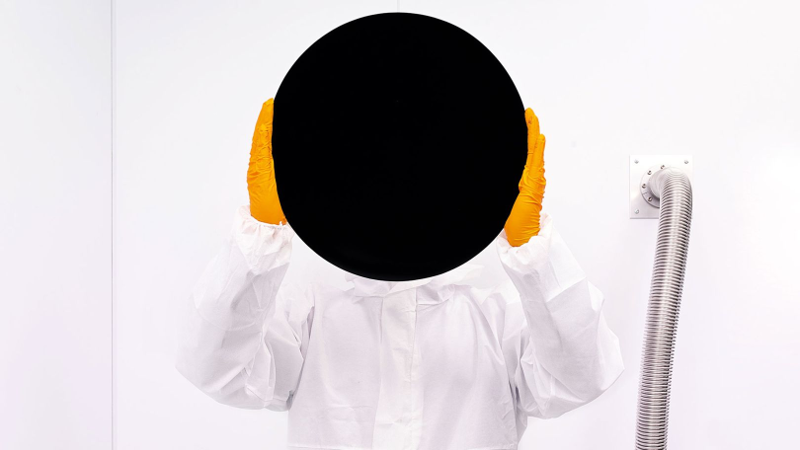Sometimes you need something to be utterly, totally, irredeemably black. Not just a little bit black, not just really really really dark blue, but as black as it is possible to get. It might be to trap light in a camera or a telescope, for artistic purposes, or even to make your warplane a more difficult target for enemy missiles. Either way, we’re here to help, not to judge. So what are your options?
Well, first of all, there’s the much-lauded Vantablack. The name itself is a clue as to its origin – Vertically Aligned Nano Tube Arrays. It works by coating an object with a forest of carbon nanotubes in a complicated vacuum deposition process. When light hits the surface, some of it is absorbed by the nanotubes, and any that is reflected tends to be absorbed by neighbouring nanotubes rather than escaping the surface coating of the object.
Like a Void in the Universe

Vantablack has the current crown for being the blackest black currently available, absorbing 99.965% of visible light. However, before you get too excited, it does have some drawbacks. In its original form, it has to be grown on materials at temperatures of 400 °C in laboratory conditions. This prevents its application on materials with a lower melting point. It does also come in a spraycan format, requiring only 100 °C to cure, however. But perhaps the biggest pitfall is that for the vast majority of users, it simply isn’t available.
The sad story of Vantablack is that, outside of industrial and military applications, it’s not purchasable by the general public. An artist by the name Anish Kapoor secured exclusive artistic rights to the material from the manufacturer, Surrey Nanosystems, leading to a feud of amusing proportions. We’d love to see a DIY method to replicate this coating, but thus far, the technical hurdles are yet to be overcome by the home chemist. This means that short of an extreme case of identity theft, you might find you need to look elsewhere.
The Offbrands: Singularity Black and Aeroglaze Z306

Coming in a close second is Singularity Black, by Nanolab. This consists of carbon nanotubes in a polymer binder which breaks down upon exposure to temperatures above 300 °C. Absorbing up to 98.5% of visible light and with similarly strong performance in IR, it’s perhaps the most high-performing alternative available. Application isn’t easy and is somewhat hazardous, though [Jason Chase] has shared the results of some experiments online. Samples of Singularity Black can be purchased readily online.
Another option is Aeroglaze Z306, used by NASA as a coating behind space-based imaging sensors. At 97% reflectivity, it’s very black, but doesn’t quite stack up against the nanotube-based Vantablack. Capable of being applied between 13-35 °C, it’s a tad easier to use, but according to the datasheet, once again not available to the average consumer.
Unfortunately, with all the above coatings, there are a lot of pitfalls. Rigorous requirements during the application process and limited robustness can cause problems for a lot of projects. Price is also a factor.
Very Black Paint

If you’re looking for the darkest black you can get without leaving the comfortable, familiar realm of things that can generally be considered “paint”, never fear — Stuart Semple’s Black 2.0 is the answer. Estimated to absorb between 95-96% of visible light, it’s a simple acrylic paint that’s been absolutely loaded with pigment, which means application is as easy as brushing it on and letting it dry, all at room temperature.
It’s not quite weatherproof (though a coating is being developed!) but is more than usable for a great many applications that have to exist in the real world. Best of all, it’s affordable and available to everyone — except Anish Kapoor.
The field of black is one of constant change and furious development, and we can’t wait to see comes next. For now, there’s plenty out on the market to choose from, and we’ve thrown some videos in below to help you decide what works best for you. That said, we’re a bit sad that we can’t find any hacker-friendly solutions for producing a Vantablack-like substance (we’ve seen a lot of other carbon nanotube uses in the home lab).
Whether it’s cutting edge paints or a way to brew up your own nanotubes at home, we want to know about it. If you’ve got a killer app for the blackest substance ever produced, let us know in the comments.
















Nature has already beaten us in the black department.
https://www.theatlantic.com/science/archive/2018/01/super-black-is-the-new-black/549869/
Wow, the feathers trap 99.95% of the light, that is amazing. Once again, nature has already figured it out. Thanks for the interesting link.
Well, “beaten” isn’t the right word there, since Vantablack is still blacker than that. But damn close.
Damn nature with its fourteen billion years of the most massively parallel trial and error, you just can’t beat that.
By following up with the question, why does it need to be that black?
As with nearly all decorative touches on males: To impress the ladies!
Tall, dark, and handsome!
B^)
By the way the blackest material, which you can currently buy is a T-shirt by Phoebe Heess.
it could be great to use in photograpny
– as a background for any wetplate process would make the picture get a contrast like never seen
– background in studios, it’ll work like chroma-key but without the color casting, the subject will always pop-out of the background no matter what lights you are using
– in adapters/lenses/macro-bellows avoinding internal reflections improves the final image projection on the sensor
I’d be worried about durability, as well as keeping it clean.
In backgrounds you’ll want some shadowcasting though, at least sometimes, as sometimes structures are created and coated in green for actors to interact with, and the shadows cast on that are actually used.
Except that it’s easy to avoid green/red/blue/etc (take your pick), but avoiding black is much harder. Especially if your actor has black hair. Or a black suit. Or a black dress.
The way the process works with traditional photography, you don’t just color key the black out. You increase the contrast in the image until the subject is just a blob of white. That creates a mask that you use to remove the background.
If the background is nearly absolutely black, even very dark objects will show up in contrast against it, limited only by your camera’s dynamic range.
Has anyone else had the terrible idea of painting their car with this?
Only if it absorbs police radar.
B^)
Or Lidar…
B^)
Bingo. . save for the fact that lidar has a v narrow beam and typically the reflective plate id targetted, for dual reasons.
The beam is not even so narrow, especially at some distance. But if you carry a retro reflector (license plate) it does not help if the rest of the car is black.
And if you remove the license plate you do not have to fear the speed traps anyway. :-)
Which isn’t a problem for cars with black plates and light text. I have some 2.0 and it is going on my plates soon.
Ceiling of your bedroom. Stare into the void as you try to fall asleep.
I was laying in bed one night looking at the stars and I thought to myself… Where’s the roof?
“I couldn’t go to sleep.”
“Why?”
“It felt like the ceiling was staring back.”
I was thinking auto companies could use it to coat R&D cars instead of the crazy zebra stripes to deter photos. It might be too expensive to be worth it though.
Maybe don’t 100% cover it, but giving your car zebra stripes could be interesting!
Yep, and then I saw Stuart’s “SHIFT”…
And then I saw “LIT” :-)
Unfortunately it’s not very rugged. The little nanotubes wear off, where they would presumably be inhaled and cause cancer. Bummer.
Carbon causes cancer?
Benzene: 6 carbons in a hexagonal ring. Not nice.
It can depend on the size and shape of the particles. Think of asbestos: Chemically only some silicate, in no way toxic. But the micrometer fine fibers find their way in to the lungs and stay there. I think the cancer causing mechanism is more or less only permanent mechanical irritation what is causing inflammation and cancer over the long term.
There is a pickup-truck I see regularly that is painted some form of super-black (darker than flat-black primer). Seems like it would be a pain to keep clean but is also very eye-catching in the uniqueness. After reading this, now I’m even more curious about the truck.
land rover defender in this colour- ulimate apocalypse wagon
Also electric car in this- pedestrians would never notice till after theyd been hit
Go fast enough and they’ll just never notice…
No, but I once thought about chroming a DeLorean.
In CA(lif) max vehicle reflective surface is 30%
I hope antiques are exempted. There’s more than a few Dusenburgs that might fail that test! :)
The combination of chrome and Vantablack could be quite interesting.
Not sure about this, but I guess a reflectivity of 97% would be pretty bad for black paint. Guess this must be a typo ;)
“At 97% reflectivity, it’s very black,”
I think you meant 97% absorption.
As of writing he’s still reflecting on your comment and we’ll see what happens when it’s absorbed.
1++
I remember a LONG time ago, like when Popular Science was a magazine with page after page of articles instead of the advertising pamphlet it has become, I saw a blurb on the blackest black possible. IIRC it was made by treating an aluminum plate with some sort of acid to bore deep narrow tunnels into the surface. The tunnels would trap incident light and make the surface appear black, but the cool thing was that the was no deposition of pigments. The surface was still composed of bright, shiny aluminum, but because of the tunnels it appeared black. Can’t imagine that would be great for the strength of the material, though.
You beat me, in concept, by several seconds. :-)
My high school physics teacher told us that a stack of infinitely thin razor blades, view edge on, would be black for the same reason.
I would consider it invisible. A stack of infinitely thin objects is still infinitely thin.
I remember that news, but all these years I thought the metal used was silver, not aluminum.
I had a chemistry years ago tell me that the fuzzy copper dendrites formed during copper plating (tiny whiskers of copper deposited during copper plating) were phenomenally black. I looked it up, they absorb 97-ish% at 0C rising to well over 99% above 200C. The problem is that they’re as fragile than a butterfly wing. I had no idea this varied with temperature, but lo and behold. You learn something new every day. So just put a heater in your sculpture and a big “don’t touch” sign. And if they do touch it, then they’ve learned something too. Vis. “learn something new every day”, above.
Maybe trap them in an areogel?
Wouldn’t the aerogel reflect a lot of light? Maybe if they were packed in densely enough.
Not really. Only the very outer layer could, the rest of the light would be absorbed by the black thingies. Copper or whatever else. Aerogel is 99.8% empty space. Then again I think aerogel is pretty delicate.
The Black 2.0 is also scented with BLACK cherry! ????????
Not even very very very dark green Ted?
https://www.youtube.com/watch?v=N8VFecEzkgk
that would be an ecumenical matter
blue ted
Pffft! I looked at those black pictures and I could see reflections. Kinda looked like the bookshelf behind me. :-P
Serves you right for buying one of these shiny monitors… ;-)
Does anyone know of a super-black fabric? It’s surprisingly hard to figure that out.
Any painting of Elvis on black velvet.
Fuligin!
“I put on the cloak… the hue fuligin, which is darker than black, admirably erases all folds, bunchings and gatherings so far as the eye is concerned, showing only a featureless dark.”
‘The Shadow of the Torturer’ by Gene Wolfe.
what about super white. something that would return 99.995% of reveived light. Not like a mirror but defracting it in any directions.
Spectralon: https://en.wikipedia.org/wiki/Spectralon But, it’s very expensive. You can substitute PTFE (I used many layers of white teflon plumbers tape in one application), or make a paint with barium sulfate: https://digitalcommons.usu.edu/cgi/viewcontent.cgi?article=1010&context=cpl_techniquesinstruments
there is semi-DIY avalibility for barium sulfate
https://www.youtube.com/watch?v=N3bJnKmeNJY&t=1301s&ab_channel=NightHawkInLight
There are mirrors that are that reflective. When I worked with ring laser gyros in the ’80s, our mirrors were claimed to be the best in the industry. I think they claimed 99.999% and that they were actually more reflective but the exact number required a security clearance and a need to know.
NGC or Honeywell?
Use florescence paint, return >100%
Isn’t
Yep, it even has a similar name. It’s called Vannawhite.
I’ll see myself out…
My reaction to the first photo…
Ah! It’s not so black, there’s white dots in… oh wait, it’s dust on my screen.
The not-quite black hackaday background makes the photo extra black. I do have a stuck red pixel in it….
I use Stuart Semple’s Black 2.0 inside my 3D printed cameras.
http://www.thingiverse.com/schlem/collections/schlaboratory-photo
Sticks to PLA like shit on a blanket. Great stuff!
“… outside of industrial and military applications, it’s not purchasable by the general public.” So you need a security clearance to use it? No surprise there.
I wonder if a satellite covered in it maybe just a shade pointed at Earth be almost completely invisible from the ground?
You have to be cleared for ‘black ops.’
no it’s a monopoly. The artist dude paid the inventors for an exclusive license to use it outside of industrial and military applications.
An export license from the UK is likely still required, for any application. This may limit a lot in what kinds of artwork it can be shown…
Would be helpful to have some comparison numbers for other ‘black’ things like tonor, black ink, typical acrylic paint, etc.
What’s up with lampblack? Coat something with soot and it’s pretty darn black.
Hmm… carbon black paint is about 96% absorption according to this:
https://wp.optics.arizona.edu/optomech/wp-content/uploads/sites/53/2016/10/Black-Coatings-to-Reduce-Stray-Light.pdf
I was pretty impressed when I saw the laser spot pretty much disappear on the Vantablack.
The black felt tape used for trim around projector screens is quite black. You don’t even notice if the projector is misaligned and part of the image is hitting the tape, it just disappears. I saved my leftovers in case I need it for something.
I bought a 142″ screen years ago, and it had a black treatment on the aluminum frame that did this as well. Even when I upgraded projectors 2 years later, the much brighter projector still could not put an image on the black frame.
Check out Singularity Black LT:
https://m.youtube.com/watch?v=mDTBR5ztEhc
Seems NanoLab can create “void black” fabrics by spray-coating a new low-temperature formulation directly on them. Also works on wood.
Hi everyone, I’m Jason Chase, the first artist to use Singularity black. Wanted to let you all know there’s a new lower temp version out and I have a lot of artworks out, not experiments that are successfully using singularity black paint and more will be coming out in the next coming weeks. Email me if you have any questions … also I’ll be participating in design week 2018 in April and unveiling something huge.
Try doing some as a hair dye. That’d be memorable. Maybe the Japanese would dig it.
Would be interesting to play around with any of them at “high energy” levels for things like passive solar heating.
(high energy is a relative term)
The extra couple of percent absorbency compared to ordinary black paint is surely not going to be worth the expense, never mind the complication and possible cancer, or rain destroying the nanotubes.
Super-hyper-megablack only has niche applications, far as I can see. Same as super-mega-white, or silver.
It was a ship of classic, simple design, like a flattened salmon, twenty yards long, very clean, very sleek. There was just one remarkable thing about it.
Uh… What was hidden under, the Lil Black Dress?
Those alternatives sound pretty cool… Unless you’re Anish Kapoor.
The line “Best of all, it’s affordable and available to everyone — except Anish Kapoor.” had me cracking up! XD
What a stupidly laughable, and yet totally understandable feud! LOL